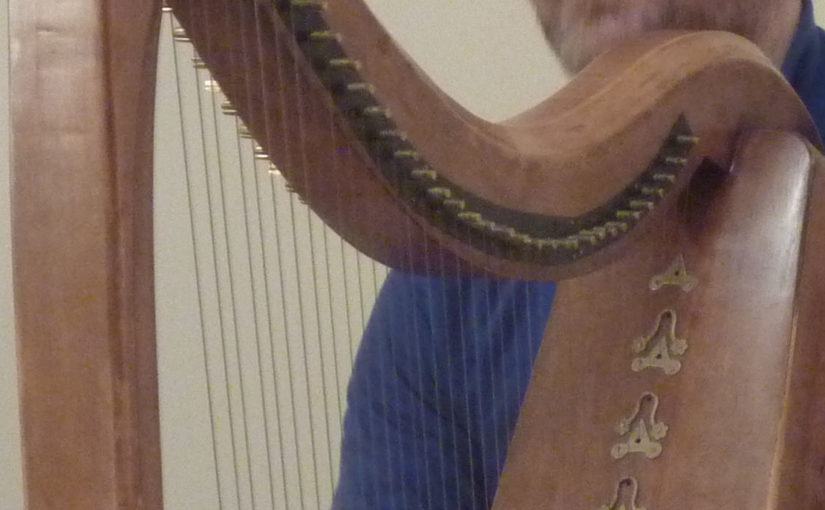I had a look at the live transcription from an old Irish harper, of “My lodgings uncertain where ever I go”, on Queen’s University, Belfast, MS4.29 page 152/149/158/f74r.
Edward Bunting wrote down this rough notation, and we can see how it looks to be basically a live transcription from the playing of the harper. You can see how it would have started as just the dots, which were then expanded out with the additions of note stems, beams, barlines and bar numbers.
There are a couple of places where Bunting has gone wrong and corrected himself; in the first half between bars 3 and 4, he has blotted out some wrong dots that go up too high; and in the second half bars 1 and 2 are written above one another and have a crazy wiggly barline to separate them out.
This reminds me a bit of his tuning sequence transcription, where he obviously went back and inserted extra information, squeezing it into the notation where he had missed stuff out.
Other information from Bunting and the harpers
As well as the transcription of our tune, page 152 contains quite a lot of writing. Above the tune, Bunting has written what looks to be a kind of title, in a darker ink: “an old Irish Tune”. Then he has, perhaps later, written more above, and below the tune. Above he writes “My Lodgings uncertain where / ever I go” and below he writes “my Dear I’ll convey you as far as”. The next line reads “Bally bay” but it is not clear whether Ballybay is the continuation of the line or not. There are other personal and place names written below this, including “Belfast”, “Munster”, “Master”, “Market”, Samson”, and “Anthony”. Many of these are common on many pages of the manuscript; Belfast is where Edward Bunting lived; Anthony was his brother from whom he learned music. At the bottom of the page, he has written “Master Higgins”.
Edward Bunting made a classical piano arrangement of this tune, which is in his unpublished “Ancient and Modern” manuscript collection (QUB SC MS4.33.2 page 26). Bunting titles this classical piano arrangement of our tune, “My Lodging’s uncertain wherever I go – an old Tune” and at the foot of the page he writes “From Hugh Higgins County Mayo”.
Bunting finally published a classical piano arrangement of this tune on p.63 of his 1809 collection. However, his title here is “Brighid inion Neill – Bridget O Neill”. The tune of this piano arrangement seems very close to that of the 1798 manuscript piano arrangement. He does not give us any more info on title or provenance in his annotated copy.
I don’t understand the different titles here.
Song words?
Donal O’Sullivan in his notes (DOSB part 6 p.50-52) does not notice the manuscript versions with the “Lodging” title at all. He tries to match Bunting’s printed 1809 title “Bridget O’Neill” with a song lyric addressed to Bridget O’Neill, which was part of Patrick Lynch’s 1802 collection in and around Westport and Castlebar.
Should we instead be looking for an English-language song which begins,
My lodging’s uncertain where ever I go;
My dear I’ll go with you as far as…
Other versions of our tune
Perhaps most importantly for us is the setting in O’Farrell’s Pocket companion vol 3, (c.1811-16), p.22, titled “My Lodging is uncertain, Irish”

There seems to be a family of tunes in old books, that are more or less related to each other, or which are variants or not of each other. Holden has two of them in his Collection of favourite Irish airs (c.1841-3) under the titles of “Lough Sheeling” (page 9) and “Kildroughalt fair” (page 34).


No.333 in O’Neill’s Music of Ireland (1903) is “Loch Saileann – Lough Sheeling”.
There is also a related tune in early 19th century Scottish books, called “My only Jo and deary O” but this is getting a bit far from our subject.
Video
I tried to play through the tune from the page 152 transcription.
The more I work at this Transcriptions Project, the more I realise how unsatisfactory these demonstration videos are. I don’t really know how “My lodgings uncertain” is meant to sound. Should it be faster, or slower? Should it be tight rythym or should it be free and long? On a micro level, which notes are the important ones and which are just curling? If we could only hear Higgins playing it!

You can hear a contemporary version of this tune performed by the band, Goitse, under the title “uncertain lodging”: https://goitse.bandcamp.com/track/uncertain-lodging
I didn’t discuss mode and tuning because there is a lot to say about this tune and all its different versions! I think this harp setting is in D pentatonic minor. The harp is tuned with F♮. The notes of D minor are D, F, G, A, C. This tune has passing notes or weak notes on the E and the B. I think that different versions of the tune especially can make the B note into B♭ (or its transposed equivalent).
In my demonstration video I probably emphasise the E too much, which pushes the tune to sounding more like a classical minor key.
D minor is an unusual setting for an old harp tune. It is related to F major pentatonic which has the notes F, G, A, C, D.
We could usefully analyse the key and mode of each of the different versions.
Here’s a PDF typeset version and machine audio, of the transcription dots on Queen’s University Belfast, Special Collections, MS4.29 p.152: